
Indralatha Temple is dedicated to Shiva and is situated in Bangomunda block near Ranipur-Jharial in Balangir district. It was supposed that Indra first worshipped lord Shiva here and erected a temple.

Indralatha Temple is dedicated to Shiva and is situated in Bangomunda block near Ranipur-Jharial in Balangir district. It was supposed that Indra first worshipped lord Shiva here and erected a temple.
This is an intact brick temple whose Jagamohana and other structures are destroyed. Only the vimana which is of Rekha deula order is existing. The innermost sanctum houses a recent installed Linga, along with old images of Vishnu, Kartikeya and Uma-Maheshwara. The old Shivalinga is displaced to outside by some attack, which proves the existing Shivalinga placed outside the temple (made of sandstone and terracotta).


The temple is maintained by Archaeological Survey of India. Being a brick temple, the time built can be traced to the 10th-11th century CE during the rule of the Somavamshi dynasty. [1] Images of Nrisimha, Vishnu along with Ganesh, Kartikeya clearly proves that it was a centre for Harihara worship. Every year Shivaratri and other festivals related to Shiva and Vishnu are organised. Daily worship is done by some local priest. Kantabanji is easily accessed by railway from Raipur and Balangir.
The only surviving brick temple of the region has possessed the cult affinity to both Saivite & Vaisnavite which is exhibited in the decoration of the outer wall. The scheme of architecture is assigned to early 10th century AD.
Indralatha Temple(ଇନ୍ଦ୍ରଲାଠ ମନ୍ଦିର)is thetallest brick temple found in Orissa (refer : External links section below) .

Aihole (ಐಹೊಳೆ), also referred to as Aivalli, Ahivolal or Aryapura, is a historic site of ancient and medieval era Buddhist, Hindu and Jain monuments in Karnataka, India that dates from the sixth century through the twelfth century CE. Most of the surviving monuments at the site date from the 7th to 10th centuries. Located around an eponymous small village surrounded by farmlands and sandstone hills, Aihole is a major archaeological site, featuring over 120 stone and cave temples spread along the Malaprabha river valley, in Bagalakote district.
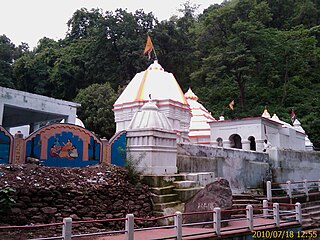
Balangir District, also called Bolangir District, is a district situated in Odisha state of India. The district has an area of 6,575 km2 (2,539 sq mi), and a population of 1,648,997. The town of Balangir is the district headquarters. The composition of the land is predominantly rural. Other important big & small towns in Balangir district are Titlagarh, Patnagarh, Kantabanji, Loisingha, Saintala, Belpada, Tushra, Agalpur, Deogaon, Chudapali, Biripali, Bhalumunda, Bangomunda, Sindhekela,Kansil, Turekela and Muribahal.

The Chausath Yogini Temple of Hirapur, also said Mahamaya Temple, is 20 km outside Bhubaneswar, the capital of Odisha state of Eastern India. It devotes to the worship of the yoginis, auspicious goddess-like figures.

The Kailasanathar Temple, Kanchipuram, also referred to as the Kailasanatha temple, is a Pallava-era historic Hindu temple in Kanchipuram, Tamil Nadu, India. Dedicated to Shiva, it is one of the oldest surviving monuments in Kanchipuram. It reflects a Dravidian architecture and was built about 700 CE by Narasimhavarman II with additions by Mahendravarman III. A square-plan temple, it has a mukha-mandapa, a maha-mandapa and a primary garbha-griya (sanctum) topped with a four-storey vimana. The main sanctum is surrounded by nine shrines, seven outside and two inside flanking the entrance of the sanctum, all with forms of Shiva. The outer walls of the temple's prakara (courtyard) is also surrounded by cells.
Matrikas (Sanskrit: मातृका (singular), IAST: mātṝkā, lit. "mothers") also called Matar or Matri, are a group of mother goddesses who are always depicted together in Hinduism. The Matrikas are often depicted in a group of seven, the Saptamatrika(s) (Seven Mothers). However, they are also depicted as a group of eight, the Ashtamatrika(s). In the Brihat Samhita, Varahamihira says that "Mothers are to be made with cognizance of (different major Hindu) gods corresponding to their names." They are associated with these gods as their spouses or their energies (Shaktis). Brahmani emerged from Brahma, Vaishnavi from Vishnu, Maheshvari from Shiva, Indrani from Indra, Kaumari from Kartikeya, Varahi from Varaha and Chamunda from Chandi. and additionals are Narasimhi from Narasimha and Vinayaki from Ganesha.

Balangir also known as Bolangir, is a town and a municipality, the headquarters of Balangir district in the state of Odisha, India. Balangir has one of the best cultural heritage in India. It is also known as one of the finest places for tourists in Odisha. Balangir municipality is divided into twenty-one wards. It is spread over an area of 12,200 acres (4,900 ha).
The Pancharama Kshetras or the Pancharamas, are a group of five ancient Hindu temples dedicated to Lord Siva, located in the Indian state of Andhra Pradesh. According to regional legend, the lingams in these temples, referred to as aramas, are believed to have been created from a single, unified Siva lingam.
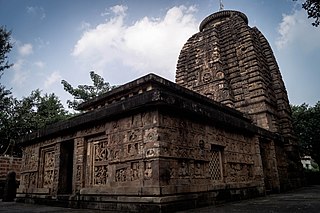
Parsurameswara Temple also spelt Parashurameshvara, located in the East Indian city of Bhubaneswar, the capital of Odisha, India, is considered the best preserved specimen of an early Odia Hindu temple dated to the Shailodbhava period between the 7th and 8th centuries CE. The temple is dedicated to the Hindu god Shiva and is one of the oldest existing temples in the state. It is believed to have been built around 650 CE in Nagara style and has all the main features of the pre-10th century Kalinga Architecture style temples. The temple is one among the Parashurameshvara group of temples.

Arulmigu Murugan Temple, Thiruparankundram is a Hindu temple dedicated to the god Murugan at Thiruparankundram, Tamilnadu, India. It is regarded as one of the "First Houses of Murugan". The temple uses rock-cut architecture and is believed to have been built by the Pandyas during the 6th century. According to legend, Murugan slayed the demon Surapadman and married his consort Devasena at the temple. Murugan is also said to have worshipped his father Shiva at the site as Parangirinathar.

The Gudimallam Lingam is an ancient linga in the Parasurameswara Swamy Temple of Gudimallam, a small village near Tirupati city in the Yerpedu mandal of the Tirupati district of Andhra Pradesh, India. It is situated about 13 kilometers south-east of Tirupati city.

The Siddhesvara Temple is located in Haveri in Haveri district, Karnataka state, India. It is considered an ornate example of 12th-century Western Chalukyan art and is well known for the many loose sculptures of Hindu deities that exist in it. However, inscriptional evidence would suggest that the initial consecration of the temple was in the late 11th century. An exciting aspect of the temple is that it faces west instead of facing the rising sun in the east–a standard in Chalukyan constructions. Though it is currently used as a Shaiva temple dedicated to God Shiva, historians are unsure by which faith or sect the temple was consecrated initially and to which deity. Many people visit the temple for their spiritual beliefs, while evidence about temple visits can be found in Gita chapter 17, verse 23, which says otherwise. Most of the Lord Shiva sculptures are observed to be of him meditating. There are claims that he meditates on himself, whereas some proof can be found in Devi-Bhagavata Purana that Lord Shiva meditates for some other God. This uncertainty perhaps stems from the many loose sculptures of deities and the degradation of primary wall images.
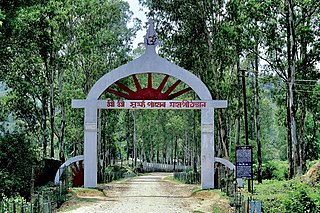
Sri Surya Pahar is located about 12 km southeast of Goalpara, about 132 km northwest of Guwahati, is a significant but relatively unknown archaeological site in Assam, India. Goalpara is the nearest city from the site. The site is a hilly terrain where several rock-cut Shivalingas, votive stupas and the deities of Hindu, Buddhist and Jain pantheon are scattered in an area of about one km. The site is centered on the hills (Pahar) of Sri Surya which is profusely filled up with Shiva Lingas (Lingam). People have found 99999 Shiva Lingas were engraved here by Vyasa in order to build up a second Kashi and once it was one of the holiest pilgrimage sites in the region. There is no historical evidence exactly how many Lingams once dotted in these hills, but still there are hundreds of them, from tiny to large in size, scattered everywhere at the foot of the hill and covering the extensive area after centuries of neglect and pilferage. The exact figure of the Lingas in the hill is yet to be counted scientifically.

Sri Sri Harisankar Devasthana is a temple on the slopes of Gandhamardhan hills, Bolangir District of Odisha in India. It is popular for its scenes of nature and connection to two Hindu lords, Vishnu and Shiva. As a holy place, along with a stream passing on the granite bed, it has given some visitors a feeling of peace. On the opposite of side of the Gandhamardhan hills is the temple of Nrusinghanath. The plateau between the two temples has been found to have ancient Buddhist ruins, which are considered to be remnants of the ancient Parimalgiri University.
The Harihara Deula or Twin Temples are dedicated to Lord Shiva and Lord Vishnu. They are situated near the bank of Mahanadi river, at Gandharadi village in Boudh district of Odisha, India.
Odisha, is an eastern Indian state on the Bay of Bengal. It is known for its tribal cultures and its many ancient Hindu temples. During the ancient times, many small kingdoms existed now known as Western Odisha, which was ruled by local chieftains.Western Odisha, or the western part of Odisha, India, extends from the Bolangir district in the south to the Sundargarh district in the north.
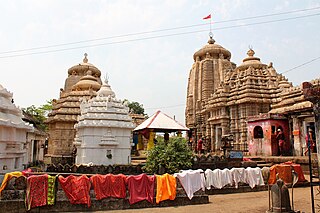
The Kapilesvara temple is a Hindu temple dedicated to Shiva located in the south western outskirt of the village Kapilesvara, Old Town, Bhubaneswar, Odisha, India. It is located at the end of Kapilesvara road leading from Lingaraj temple to Kapilesvara Village. The presiding deity is a Siva-lingam at the center of a circular yonipitha inside the sanctum. It is a living temple, facing towards east and maintained by Kapilesvara Temple Trust Board. The temple is situated within the precinct along with 33 other monuments. The precinct is located on the northern embankment of Manikarnika tank over an area of 44.00 square metres.
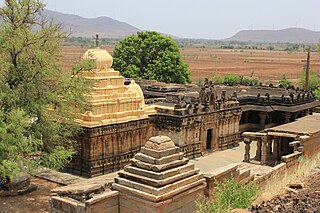
Kalleshwara temple is located in the village of Bagali it was 9km away from Harpanahalli city in the Vijayanagara district of Karnataka state, India.
Bangomunda is a tehsil,in the Balangir district of Odisha, India with historical importance. It is located 72 km from the district in the town of Balangir. Bangomunda was formerly known as Banganmura which means Brinjal Firm.

Chausath Yogini Temple of Ranipur Jharial in Balangir District, Odisha, is one of the circular, open air Yogini temples of India, dedicated to the 64 Yoginis. It appears to be an early temple from soon after 900 CE, and the presence of other temples indicates that it was an important site at that time. The surviving central shrine holds an image of dancing Shiva; all the Yogini images are, uniquely, similarly shown dancing.

The Yogini temples of India are 9th to 12th century roofless hypaethral shrines to the yoginis, female masters of yoga in Hindu tantra, broadly equated with goddesses especially Parvati, incarnating the sacred feminine force. They remained largely unknown and unstudied by scholars until late in the 20th century. Several of the shrines have niches for 64 yoginis, so are called Chausath Yogini Temples ; others have 42 or 81 niches, implying different sets of goddesses, though they too are often called Chausath yogini temples. Even when there are 64 yoginis, these are not always the same.
20°17′13″N82°58′06″E / 20.287079°N 82.968255°E
Sorrunded by a big wall-covered with weeds-weedsand small bushes are found on the temple-lack of management.